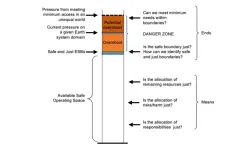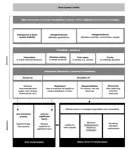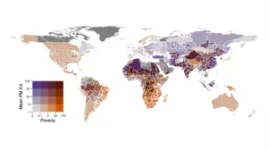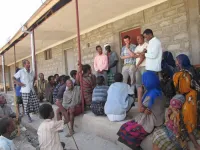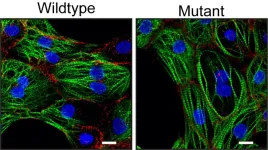(Press-News.org) In a new study published in Nature Sustainability an international team of scientists from the Earth Commission, convened by Future Earth, investigates how global biophysical boundaries need to be adjusted to ensure a safe and just future for people, nature and the planet. The Earth Commission is the scientific cornerstone of the Global Commons Alliance
This new framework integrates methods to reduce harm to people, increase access to resources, address tradeoffs, and challenge powerful interests whilst addressing inequality between generations and between humans and nature within discussions on Earth system boundaries.
“These topics still require debates and engagement with different knowledge systems - to meet the principles of procedural and recognition justice - on the structural and systemic changes that are needed to ensure a more just resource consumption so that the needs of all people can be met whilst ensuring justice between species and a stable Earth system”, lead author Joyeeta Gupta, Co-Chair of the Earth Commission and Professor of Environment and Development in the Global South at the University of Amsterdam, explained.
The research comes ahead of an associated Earth Commission report due out in early 2023 that defines ‘safe and just’ ‘Earth System Boundaries’ (ESBs) to safeguard a stable and resilient planet. These ESBs will underpin the setting of new science-based targets for businesses, cities and governments to address the polycrises of: increasing human exposure to the climate emergency, biodiversity decline, mass extinction of species that threaten the stability of the planet.
In the paper, researchers argue that Earth System Boundaries must not only ensure the stability of the planet but also protect humans and other species from significant harm. This might require more stringent targets; however, such stringent targets may also influence the access of people to basic resources and the allocation of resources. Building on the scholarship on justice, they define the concept of Earth system justice, offering a theoretical framework for Earth system justice, operationalizing it and additionally outlining the transformations required to do so. This entails substantive and procedural justice where substantive justice aims at ensuring access to minimum resources, reducing harm, and allocating responsibilities fairly. Procedural justice implies that people should be able to access information, participate in decision making, enjoy civic space and the right to go to courts. Adjusting biophysical targets to ensure that the poor have access to resources and the vulnerable are protected from harm is needed.
“While it is important to establish boundaries for climate change, biodiversity, water, and pollution that ensure a stable and safe earth system we also need to consider how such boundaries can also be just in minimizing harm to humans and nature. This includes avoiding tradeoffs, and ensuring that we meet the goals of sustainable development in ensuring that everyone has access to the energy, food, water and other resources for a dignified life”, said Diana Liverman, Earth Commissioner and Regents professor at the University of Arizona.
“We need to assess who is most responsible for Earth system change, who is most vulnerable to it, and who should take action to reduce the risks and reallocate resources, responses and risks in line with principles of justice”, she added.
At the core of Earth System Justice the researchers consider the need for justice among present nations, communities and individuals (Intragenerational Justice), justice for future generations (Intergenerational justice) and for other living things and Earth system stability (‘Interspecies Justice and Earth system stability’). To operationalise the framework, they evaluate if safe (ecological and physical) Earth system boundaries reduce harm to the most vulnerable while ensuring 'just access’ to food, water, energy and infrastructure.
The authors argue that if we are to achieve truly just and sustainable futures, we need to grapple with what Earth system justice means and how it can be put into practice. This will ensure that historical and present injustices are addressed and not continuously postponed or reproduced. The authors conclude that living within planetary limits must include attention to justice.
- ENDS -
END
Africa, where humans first evolved, today remains a place of remarkable diversity. Diving into that variation, a new analysis of 180 indigenous Africans from a dozen ethnically, culturally, geographically, and linguistically varied populations by an international scientific team offers new insights into human history and biology, and may inform precision medicine approaches of the future.
The work clarifies human migration histories, both historical and more recent, and provides genetic evidence of adaptation to local environments, ...
More than two million citizens across 30 European countries have been involved in thousands of projects and initiatives as part of efforts to transition to renewable energy, according to an analysis published in Scientific Reports. With investments ranging between 6.2 and 11.3 billion Euros, these findings highlight the important role of collective action in the decarbonisation of Europe.
The energy system in Europe is undergoing a significant transition towards renewables and decarbonisation. However, the contribution ...
About The Study: The findings of this study suggest that despite calls for the expansion of outpatient surgery to mitigate the growing backlog of surgical cases in the wake of the COVID-19 pandemic, uptake of this practice occurred in only a small subset of operations. Further studies should explore potential barriers to the uptake of this approach, particularly for procedures that have been shown to be safe when performed in an outpatient setting.
Authors: Cornelius A. Thiels, D.O., M.B.A., of the Mayo Clinic in Rochester, Minnesota, is the corresponding author
To access the embargoed study: Visit our For The Media website at this link https://media.jamanetwork.com/
(doi:10.1001/jamanetworkopen.2023.1198)
Editor’s ...
About The Study: The results of this study of more than 20,000 men with low-risk prostate cancer suggest that active surveillance rates are rising nationally but are still suboptimal, and wide variation persists across practices and practitioners. Continued progress on this critical quality indicator is essential to minimize overtreatment of low-risk prostate cancer and by extension to improve the benefit-to-harm ratio of national prostate cancer early detection efforts.
Authors: Matthew R. Cooperberg, M.D., M.P.H., of the UCSF Helen Diller Family Comprehensive Cancer Center in San Francisco, is the corresponding ...
Researchers from the group of Eva van Rooij in collaboration with the UMC Utrecht identified a new mutation that leads to the cardiac disease arrhythmogenic cardiomyopathy (ACM). They assessed the effect of this mutation on heart muscle cells and obtained new insights into the underlying mechanism that causes the disease. The results of this study, published on March 2nd in Stem Cell Reports, could contribute to the development of new treatments for ACM.
Desmosomes
Millions of heart muscle cells contract to let the heart fulfill ...
WASHINGTON, DC – The Patient-Centered Outcomes Research Institute (PCORI) today kicked off a multiyear initiative with an initial investment of $50 million to advance the uptake of practice-changing comparative clinical effectiveness research results into health care practice with the selection of 42 U.S. health systems to participate in its groundbreaking Health Systems Implementation Initiative (HSII). In addition, PCORI initiated the first in two stages of HSII funding, focusing on initial capacity-building efforts.
The array of participating health systems representing a wide range of care settings and populations will develop and implement ...
High in a narrow, seawater-filled crevasse in the base of Antarctica’s largest ice shelf, cameras on the remotely operated Icefin underwater vehicle relayed a sudden change in scenery.
Walls of smooth, cloudy meteoric ice suddenly turned green and rougher in texture, transitioning to salty marine ice.
Nearly 1,900 feet above, near where the surface of the Ross Ice Shelf meets Kamb Ice Stream, a U.S.-New Zealand research team recognized the shift as evidence of “ice pumping” – a process never before directly observed in an ice shelf crevasse, important to its stability.
“We were looking at ice that ...
Party loyalty and partisan motivation may interfere less with Americans’ thinking than previously believed, MIT behavioral researchers Ben M. Tappin, Adam J. Berinsky, and David G. Rand report in new research published in the journal Nature Human Behaviour.
The study, which looked at how Democrats and Republicans react to persuasive messaging that doesn't align with their party leader’s position, challenges the view that party loyalty distorts how Americans process evidence and arguments.
“Our results are clear and unequivocal: Learning the in-party leader’s ...
Even in their dark isolation from the atmosphere above, caves can hold a rich archive of local climate conditions and how they've shifted over the eons. Formed over tens of thousands of years, speleothems — rock formations unique to caves better known as stalagmites and stalactites — hold secrets to the ancient environments from which they formed.
A newly published study of a stalagmite found in a cave in southern Wisconsin reveals previously undetected history of the local climate going back thousands of years. The new findings provide strong ...
• The blood-brain barrier prevents most drugs from reaching brain tumors.
• A new method using nanoparticles transported drugs across this barrier in mice.
• The nanoparticles target a protein on tumor blood vessel cells called P-selectin.
• The nanoparticles improved the treatment in a model of aggressive pediatric brain cancer
Brain tumors are notoriously hard to treat. One reason is the challenge posed by the blood-brain barrier, a network of blood vessels and tissue with closely spaced cells. The barrier forms a tight seal to protect ...
